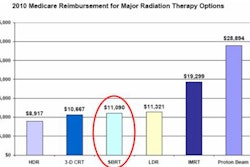
In an attempt to minimize such errors and improve treatment safety, a team at the Ottawa Hospital Cancer Center in Ottawa, Ontario, has implemented an incident learning system for managing radiotherapy errors. They detail their initial experience in an article published online in Radiotherapy and Oncology (April 20, 2010).
The incident learning system works by documenting any "unwanted or unexpected change from normal system behavior that causes or has the potential to cause an adverse effect to persons or equipment." One important feature is that it includes potential, as well as actual, incidents, enabling proactive implementation of error management measures.
The system was introduced at the Ottawa Hospital Cancer Center in January 2007 and during the following three years documented 1,808 reports, an average of 11.6 incidents per week. During this time, a total of 203,304 treatments were delivered.
The system categorizes all recorded incidents as critical (patient death/disability, dose variation above 25%, for example), major (dose variation of 10%-25%, major side effects), serious (dose variation of 5%-10%, minor side effects) or minor (dose variation below 5%), and further defines them as clinical, operational, occupational, environmental, or security/other. It also details four work domains in which the incident could occur: prescription, scheduling, treatment preparation, and treatment delivery.
For all incidents, the basic cause is determined and strategies identified that could correct system weaknesses. The system is managed by a multidisciplinary team that meets weekly to direct the investigation process.
Error reduction
During 2007, 2008, and 2009, the system reported 658, 686, and 461 incidents, respectively. Most of these (around 98%) were minor or potential, with little or no impact on patients. The number of actual incidents fell significantly during this time: from 117 in 2007, to 84 and 62 in the successive two years.
One critical incident was reported in 2007 and one in 2009, both geographic misses. Five actual and four potential major incidents were recorded in 2007, two actual and two potential major incidents in 2008, and none in 2009. For serious incidents, the figures (actual/potential) were 24/20, 16/5, and 18/8, for 2007, 2008, and 2009, respectively. The ratio of potential/minor incidents to serious/major/critical incidents -- an indicator of system effectiveness -- increased from 25.3 in 2007 to 99.0 in 2008, and then fell to 50.2 in 2009.
Most incidents (92.8%) were classified as clinical (such as geographic miss, incorrect shielding, incorrect treatment parameters, etc.), with most clinical incidents reported during treatment preparation. The number of actual clinical incidents reduced successively over the three years, from 86 in 2007, to 54 in 2008, and 36 in 2009.
The number of actual incidents originating at the treatment unit also fell, from 58 in 2007, to 26 in 2008, and 20 in 2009. The researchers attribute this to the introduction of electronic treatment parametertransfer and increased imaging capabilities. They note that of the geographic misses reported representing the treatment delivery incident most likely to result in harm to the patient, none occurred on a radiotherapy unit equipped with daily image guidance.
The majority of incidents were assigned the same basic cause, namely that standards, procedures, or practices were not followed, developed, or adequately communicated. The single most frequent task likely to result in error was transcription. Although technology has eliminated a lot of the need for manual transcription, any remaining transcription tasks provide potential for error. The researchers have thus implemented several strategies to reduce such tasks.
The Ottawa team attributes the reduction in actual incidents during the study period to the introduction of interventions prompted by analysis of reported incidents. Staffing levels were altered to concentrate on more vulnerable areas of the treatment process, for example, and quality assurance processes modified to focus on weaknesses in treatment preparation.
The authors conclude that implementing the incident learning system has reduced the occurrence of actual incidents and encouraged reporting of potential incidents, enhancing the culture of safety. They note that staff acceptance was high, with compliance to voluntary reporting much improved over a previous scheme.
"Probably the main outcome of introducing this system has been to increase multidisciplinary collaboration on quality improvement," said Brenda Clark, PhD, chief of medical physics at the Ottawa Hospital Cancer Center. "The incident reports and subsequent root cause analyses have provided motivation for the group to work in a nonblaming and nonpersonal way to provide permanent robust solutions to some of the inefficiencies and flaws in our processes."
By Tami Freeman
Medicalphysicsweb editor
July 2, 2010
Related Reading
Italian rad oncologists go proactive to reduce adverse events, February 8, 2010
Options abound for radiation therapy QC, August 19, 2008
QA tool cuts errors in radiation oncology department, August 6, 2008
© IOP Publishing Limited. Republished with permission from medicalphysicsweb, a community Web site covering fundamental research and emerging technologies in medical imaging and radiation therapy.



















